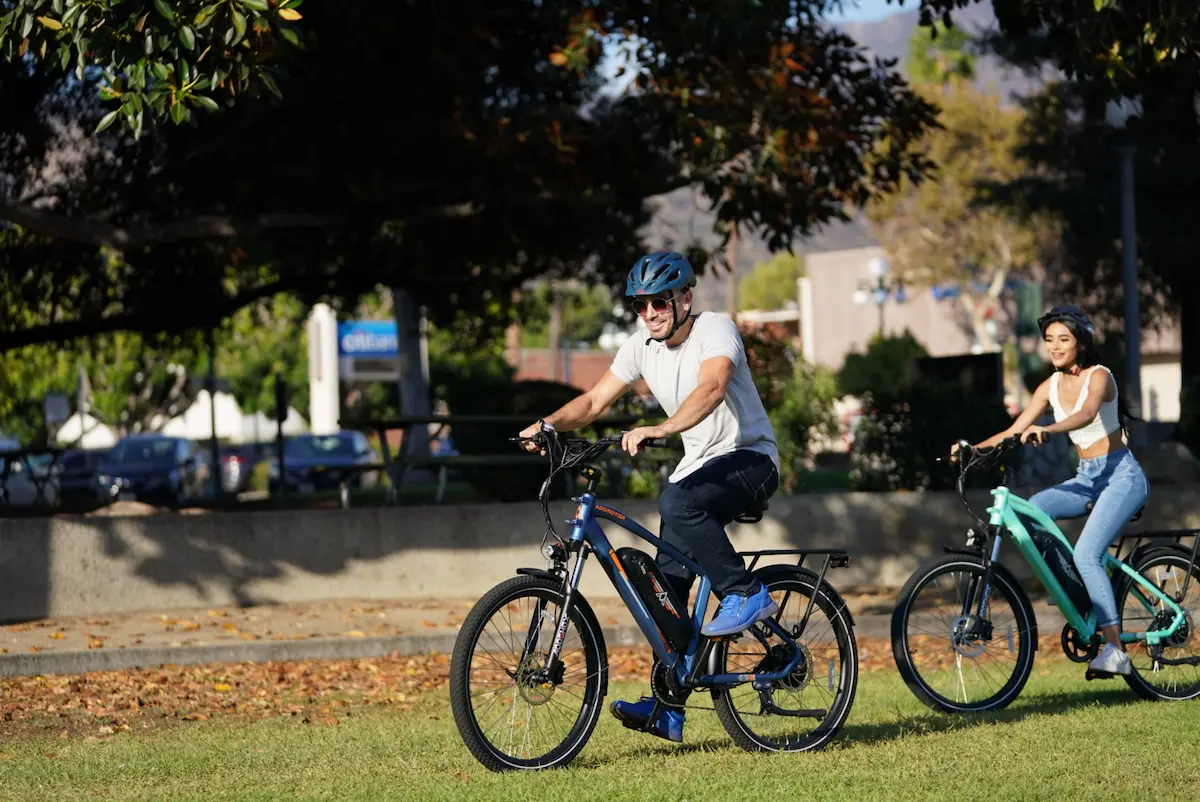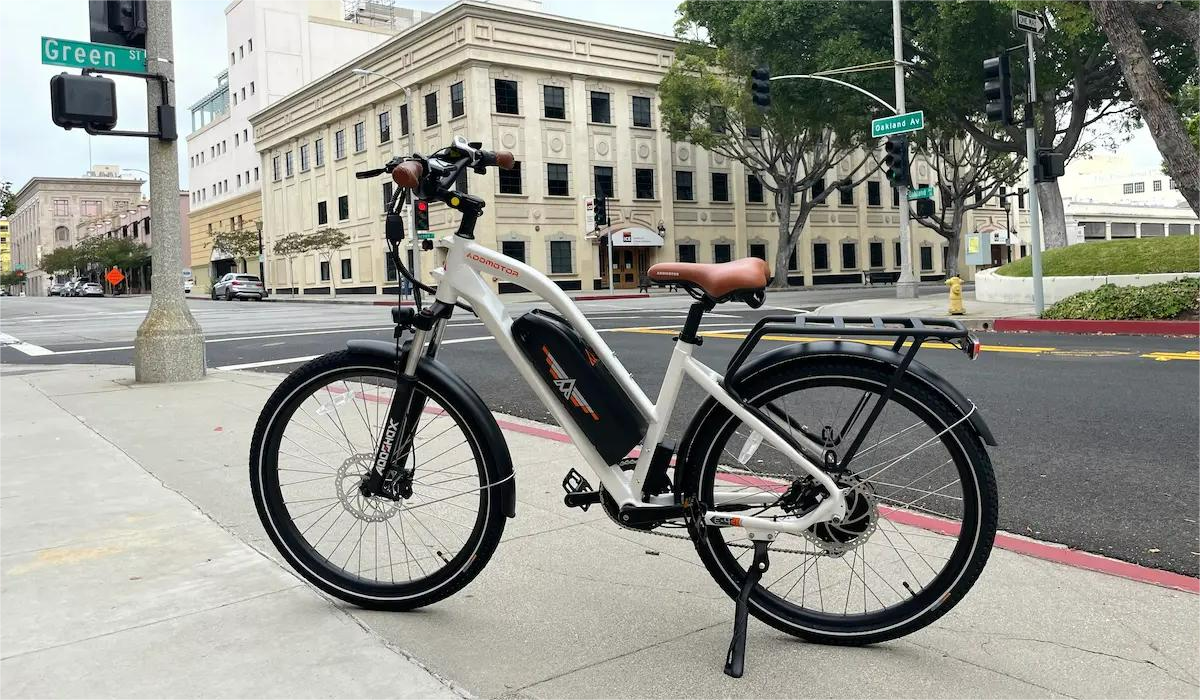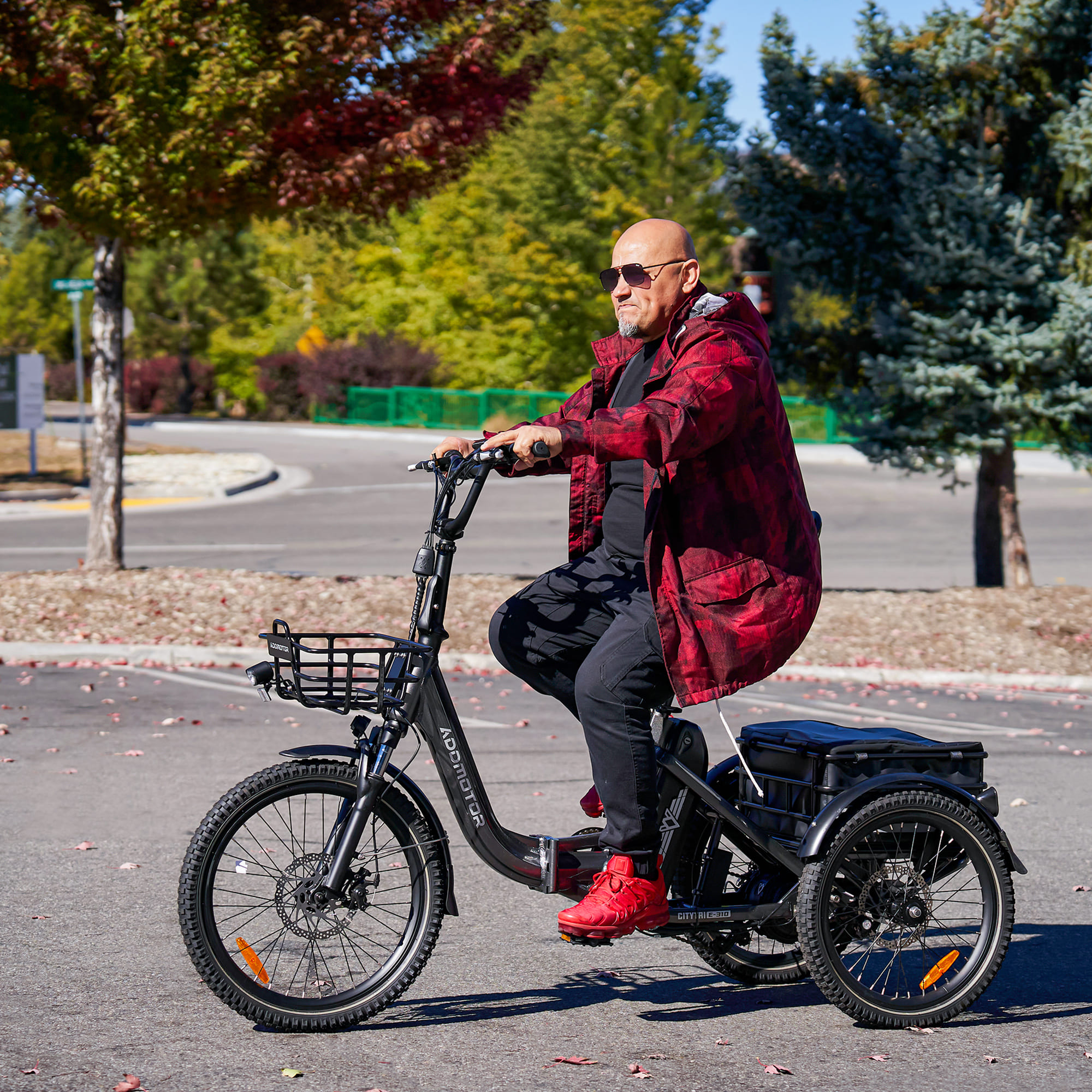The new wave of cycling: Electric Bike tax rebates and safe riding for Modern Cyclists
By Addmotor | 20 April 2023 | 0 Comments

E-bikes are becoming increasingly popular as a dependable, environmentally friendly, and adaptable mode of transportation. The bicycle boom of 2020 witnessed an increase in the number of Americans cycling on both traditional and electric bikes. E-bikes are increasingly being used for traveling, cruising, hunting, and fishing. Adopters of ebikes may soon be compensated with a tax rebate on their eBike purchases.
The initial effort to pass a nationwide e-bike rebate was unsuccessful. But this time, the bill has more backers and a larger number of supporters.
What is the E-Bike ACT?
2 Congressmen introduced the E-Bike Act on February 11th, 2021. The full name of the Act is the Electric Bike Incentive Kickstart for the Environment (E-BIKE) Act. The Act's purpose is to encourage the ongoing use of e-bikes or electric bikes by offering consumers an exemption against their income taxes.The Congressmen support the use of electric bicycles as a means of transportation that may enhance their distance, pace, and accessibility while decreasing carbon emissions. Congressman Earl is also the Chairman of the Congressional Bike Caucus and a well-known cyclist. The Congressmen believe that eBikes should be widely available as a viable and practical means of transportation that helps to reduce carbon emissions. By providing a rapid and dependable alternative method of transportation, electric bicycles have the potential to reduce automotive trips and emissions.
E-bikes let individuals get around swiftly and effectively in both urban and rural settings. They are also appropriate for all types of riders, regardless of age or physical ability. Despite the fact that eBikes lessen the pressure of pedaling and physical exertion, they may still be a terrific form of exercise.
As the government seeks to cut carbon emissions and battle climate change, numerous congressmen and women have recognized the importance electric bicycles may play in removing vehicles off the road. They recognize that ebikes for adults are a viable means of transportation that keeps people moving, active, and connected while minimizing environmental effects.
Tax Rebate
A plan to give Americans a $1,500 discount on a new electric bicycle was proposed in Congress this week, less than a year after a similar provision was omitted from the climate-focused Inflation Reduction Act.The original Electric Bicycle Incentive Kickstart for the Environment (E-BIKE) Act was launched in 2021 as a method to assist in defraying the expenses of an e-bike, which may be costly but has been found to minimize automobile journeys for many users. The measure was updated after being included in President Joe Biden's Build Back Better legislation, however, it was later eliminated after the package evolved into the Inflation Reduction Act. The new E-BIKE Act is nearly identical to its predecessor, even down to the use of the same terminology.
The proposed measure would provide a refundable tax credit of up to $1,500 on the acquisition of a new e-bike. This is an improvement over the previous E-BIKE Act's revised version, which would've restricted the credit to $800, and is consistent with the initial 2021 version. The credit would also be entirely refundable, allowing lower-income persons to apply for it.
Bikes costing more than $8,000 would be ineligible for the tax credit, an increase from the revised version, which restricted the price to $4,000. Income levels are also modified.
Other significant advancements have occurred since the original E-BIKE Act was established. Several towns and states have implemented their local versions of an e-bike tax credit to considerable applause. Denver, for example, created its voucher programme, offering $400 off the purchase of a new e-bike and up to $1,200 off for low-income people. Anyone who buys an electric cargo bike will receive a $500 bonus.
Meanwhile, e-bike sales continue to soar, while regular bike sales begin to level off after the pandemic-era biking boom. Furthermore, more businesses are introducing cargo-carrying versions in an obvious attempt to attract consumers and families who wish to replace automobile journeys.
Addmotor provides its variant for electric cargo bike as GAROOTAN M-81. This cargo bike has a 750-watt rear brushless motor with over 105+ miles on a single charge on its 20 Ampere hour UL-certificated Samsung battery. The payload capacity for the M-81 cargo bike is 350 pounds. Standing at $1,800 only, this bike comes well under that E-BIKE ACT.
► Other issues Addressed
The E-BIKE Act would also address recent battery quality issues raised by a spate of fires in New York City caused by malfunctioning e-bike batteries. To assure quality, the measure would require qualified bikes to have drivetrains and batteries approved by the insurers’ Laboratory's standard UL 2849. The New York City Council recently enacted legislation requiring all e-bikes sold in the city to meet the UL standard.
The Addmotor Electric bike is equipped with a UL-certified lithium-ion battery. This means that it has passed safety tests and is safe to use. The battery on the Addmotor Electric bike is UL-certified, meaning that it meets all safety standards. This is important for peace of mind when using the bike. The battery has a capacity of 10.4 Ah and a voltage of 48V, giving it a range of up to 90 miles on a single charge. It is also equipped with a smart battery management system (BMS) that monitors the battery and ensures its longevity.
The UL-certified battery is also designed to be long-lasting and reliable. It has a lifespan of up to 1000 charge cycles, which means it will last for many years. Additionally, the battery is equipped with an LCD indicator that shows the remaining charge level, so you always know when it is time to recharge.
► What electric bikes are eligible for the tax credit??
The Bill defines a qualifying electric bicycle as a "two-wheeled vehicle that is, among other things, equipped with an electric motor of fewer than 750 watts capable of propelling such vehicle." Except for those with 1000-watt motors, this criteria will apply to the majority of Addmotor bikes along with the top electric bikes now on the market.Eligible for affordable electric bikes must be class 1 electric bicycles, class 2 electric bikes, or class 3 electric bicycles, and must have the following features:
• An electric motor rated at less than 750 watts
• Pedals that can propel the vehicle
• The rider's saddle or seat
• The taxpayer must purchase the bikes in the United States. The bike must also be brand new, not leased or purchased secondhand.
Addmotor offers several models of long-range electric bikes that are designed to travel further distances without the need for recharging. A commute ebike, the citypro series has the longest range in the Addmotor livery giving about 125+ miles of range on a single charge. The fact that these e-bikes consist of 750-watt batteries only is one good piece of engineering. City Pro E-43 is one of these long-range models. These long-range Addmotor electric bikes from Addmotor are designed for traveling long distances without worrying about running out of battery power. The bikes are made in traditional bike design with slimmer aluminum bodies to handle that extra mileage.

Customers are benefited from tax rebates for e-bikes in several ways:
Affordability: Tax rebates make e-bikes more affordable for customers, reducing the cost barrier to entry. E-bikes can be expensive compared to traditional bicycles, so tax rebates can make them more accessible to a wider range of customers.Sustainability: E-bikes are a sustainable and eco-friendly mode of transportation, and tax rebates encourage more people to switch to e-bikes from traditional gas-powered vehicles. This not only benefits the environment but also reduces dependence on fossil fuels and lowers carbon emissions.
Health: E-bikes can improve public health by promoting physical activity and reducing sedentary behavior. With tax rebates, more people can afford to purchase e-bikes, and this promotes a healthy lifestyle.
Convenience: E-bikes are convenient for commuting and getting around town. With tax rebates, more people can afford to purchase e-bikes, and this promotes a more convenient mode of transportation.
Safety: E-bikes can be safer than traditional bicycles because they allow riders to travel at faster speeds with less physical effort. With tax rebates, more people can afford to purchase e-bikes, and this promotes safer cycling practices.
In summary, tax rebates for e-bikes benefit customers by making them more affordable, promoting sustainability, improving public health, providing convenience, and promoting safety. By incentivizing the adoption of e-bikes, governments can promote a healthier, more sustainable, and more efficient transportation system.
E-bike companies benefitted:
E-bike companies would even take advantage of tax rebates as they could work to lobby for tax rebates and other incentives at the local, state, and national levels. This can involve working with government officials and advocacy groups to educate them about the benefits of e-bikes and to push for policies that promote their use. By doing so, e-bike companies can help to create a more favorable environment for their products and for cycling more broadly.Finally, e-bike companies can also take advantage of tax rebates and other incentives to invest in research and development, improving their products and making them more appealing to consumers. For example, a company may use tax rebate funds to invest in battery technology, making their e-bikes more efficient and increasing their range. Similarly, they may use these funds to invest in safety features, such as better braking systems or more visible lights.
In many countries, governments are taking steps to incentivize the use of adult electric bikes. One such incentive is tax rebates for those who purchase e-bikes. For example, in the United States, the federal government offers a tax credit of up to 30% of the cost of an e-bike, up to a maximum of $1,500. This credit is available to individuals and businesses who purchase e-bikes for personal or work-related use. Similarly, in the United Kingdom, the government has launched a program that provides a grant of up to 20% of the cost of an e-bike, up to a maximum of £350. These tax rebates make it more affordable for people to purchase e-bikes, which can cost several thousand dollars. In addition, they can help to offset the cost of other necessary equipment, such as helmets, lights, and locks.
The benefits of promoting the use of e-bikes through tax rebates are significant. E-bikes are a greener and more sustainable mode of transportation than cars and can help to reduce traffic congestion and air pollution. They can also help to improve public health, as cycling is a low-impact form of exercise that can help to reduce the risk of obesity, heart disease, and other health problems. Finally, promoting the use of e-bikes can help to reduce dependence on fossil fuels and promote more sustainable forms of transportation.
However, it is important to note that ebike rebates alone are not enough to promote the widespread adoption of e-bikes. In addition to financial incentives, cities must also invest in safe infrastructure and education campaigns to make cycling a viable option for everyone.
Safe Riding for the Modern Cyclist
While cycling is a great way to travel, it can also be dangerous if proper safety precautions are not taken. The rise of e-bikes has led to concerns about their speed and how they interact with other vehicles on the road. As a result, many governments are taking steps to ensure the safety of modern cyclists on the road.One of the ways that governments are promoting safe riding is by investing in infrastructure such as bike lanes, signage, and traffic signals. For example, New York City has committed to building 30 miles of protected bike lanes each year to make cycling safer and more accessible to all.
Another way that governments are promoting safe riding is through education campaigns. For example, the Dutch government has been running a successful campaign called "Think Bike" to promote safe cycling habits and raise awareness among motorists about the importance of sharing the road with cyclists.
Steps by the government to ensure modern ebike cyclist safety:
Governments can play a crucial role in making modern cyclists safe by implementing policies and infrastructure that prioritize cycling as a safe and sustainable mode of transportation. Here are some ways that governments can help make modern cyclists safe:Infrastructure Investment: Governments can invest in cycling infrastructure, such as bike lanes, paths, and parking facilities. These facilities provide safe spaces for cyclists to ride and park their bikes, reducing the risk of accidents and theft.
Traffic Calming Measures: Governments can implement traffic calming measures, such as speed limits, roundabouts, and traffic circles, to reduce the speed and volume of traffic on roads where cyclists and motorists share the space.
Education and Outreach: Governments can provide education and outreach programs to promote safe cycling practices and raise awareness among motorists about the rights and needs of cyclists on the road.
Legislation and Enforcement: Governments can pass and enforce laws that protect the rights of cyclists on the road, such as laws requiring motorists to give cyclists a minimum safe passing distance.
Collaboration with Stakeholders: Governments can collaborate with cycling advocacy groups, transportation planners, and other stakeholders to develop policies and infrastructure that prioritize cycling as a safe and sustainable mode of transportation.
Incentives: Governments can provide incentives, such as tax credits or subsidies, for individuals and businesses that use or promote cycling as a mode of transportation. These incentives can encourage more people to take up cycling and make it a safer and more viable transportation option.
By taking these steps, governments can help to make modern cyclists safe and encourage more people to take up cycling as a sustainable and healthy mode of transportation. Safe cycling infrastructure and policies benefit not just cyclists, but also motorists and pedestrians by reducing traffic congestion, air pollution, and the risk of accidents and injuries on the road.
The rise of fat tire ebikes represents a significant shift in transportation, offering a more sustainable and affordable alternative to traditional cars. However, in order to promote the widespread adoption of e-bikes, governments must take steps to incentivize their use through tax rebates and other financial incentives. By doing so, they can help to promote greener and more sustainable forms of transportation, while also improving public health and reducing traffic congestion.
_1682147085.png) Speaking of traffic reduction and space consumption one option is the folding electric bike, the Foldtan M-140 is the best solution by Addmotor to this issue, it is perfect for commuting, traveling, and exploring new places. The foldability would come at a cost of mileage and battery capacity but standing at 20 Ah battery gives out 100+ miles on a single charge which is a lot considering the bike can fold.
Speaking of traffic reduction and space consumption one option is the folding electric bike, the Foldtan M-140 is the best solution by Addmotor to this issue, it is perfect for commuting, traveling, and exploring new places. The foldability would come at a cost of mileage and battery capacity but standing at 20 Ah battery gives out 100+ miles on a single charge which is a lot considering the bike can fold.► The Advantages of Electric Bikes
Electric bikes are a game changer for individuals searching for an environmentally sustainable, practical, and convenient means of transportation. When cycling, the electric motor assists, making it simpler to climb hills and cover longer distances. This implies that commuting cyclists may go longer without breaking a sweat, and individuals with physical disabilities can still enjoy cycling. The fat tire electric bikes give help in this as well, as they are prone to last longer and go further.E-bikes are also a less expensive option than driving or utilizing public transportation. They can be charged for pennies and require far less maintenance than automobiles or motorcycles. Furthermore, electric bikes are environmentally benign, emitting no pollutants and lowering the carbon imprint.
Addmotor gives its hand on this side with an electric cruiser bike the Herotan M-65x. This bike has a step-over frame. Also having a Banana Seat configuration, makes it easy for carrying a passenger. The 750-watt motor combined with the 20Ah battery can carry a load of 300lbs for up to 105+ miles. It costs around $2,399 which is still viable considering all the options and the other bikes in the market have way more pricing.
Conclusion
In conclusion, the new wave of biking presents exciting opportunities for modern cyclists to enjoy the benefits of electric bikes and support sustainable transportation options. With the introduction of tax rebates for e-bikes, more people can afford to make the switch to electric cycling, leading to reduced carbon emissions and better air quality. Additionally, by prioritizing safe riding habits and infrastructure, cyclists can feel confident and secure on the road, further promoting cycling as a sustainable and healthy mode of transportation.The new wave of cycling is not just about technology or tax rebates. It is also about the culture of cycling and the sense of community that it creates. Cycling is a social activity that connects people with the environment around them. It promotes health and wellness, encourages exploration, and fosters a sense of adventure. As more people embrace cycling as a mode of transportation, we can expect to see more innovation in the cycling industry, from the design of the bikes themselves to the development of new infrastructure and technologies. We can also anticipate more collaboration between governments, advocacy groups, and businesses to promote sustainable transportation and create a more livable and equitable future.
At the same time, it is important to recognize that there are still challenges to overcome in making cycling safe and accessible for all. Many cities and towns still lack adequate cycling infrastructure, and there is a need for more education and outreach to promote safe cycling practices and raise awareness about the benefits of cycling.
Nevertheless, the new trend of biking offers a promising vision for a more sustainable and healthy future. By embracing cycling and supporting policies and infrastructure that prioritize safe and sustainable transportation, we can create a world that is more connected, more vibrant, and more resilient.
Governments, cycling advocacy groups, and transportation planners all have a role to play in supporting the growth of cycling and ensuring safe riding practices. By investing in cycling infrastructure, providing education and outreach programs, passing and enforcing laws that protect the rights of cyclists, and offering incentives, we can create a safer and more accessible cycling environment for all.
As we look toward the future, we can anticipate even more progress in the realm of sustainable transportation, and e-bikes and cycling will surely be at the forefront of that movement. By continuing to support electric bikes and prioritizing safe cycling practices, we can create a better and more sustainable world for all.
Leave a Reply
Your email address will not be published.Required fields are marked. *
Latest Stories




